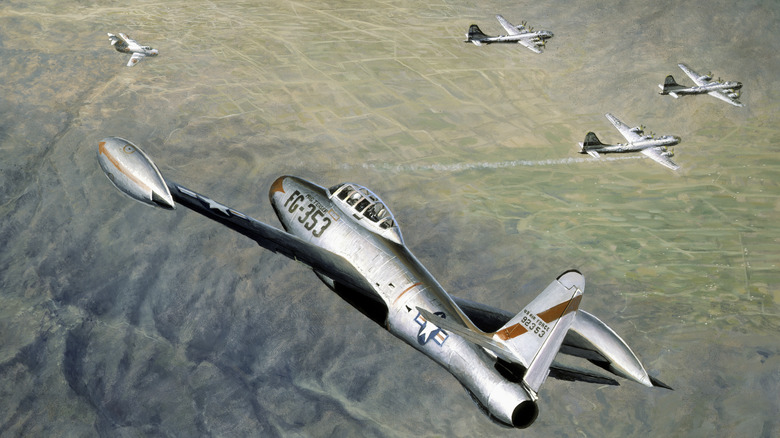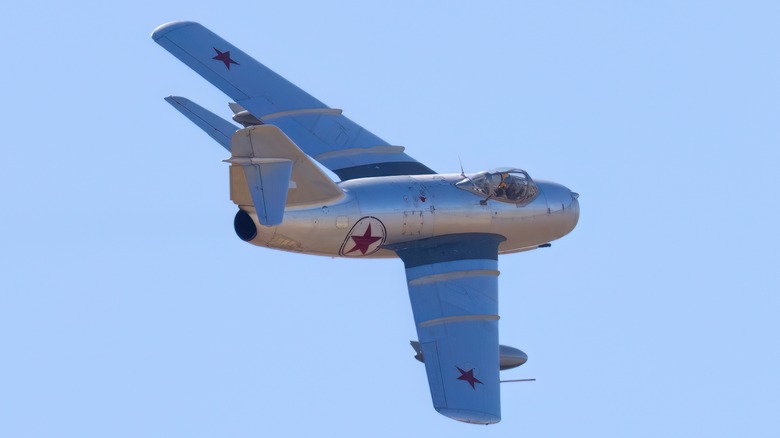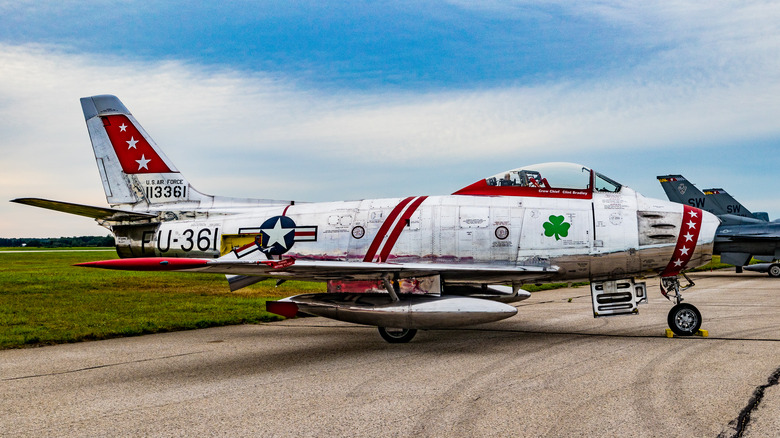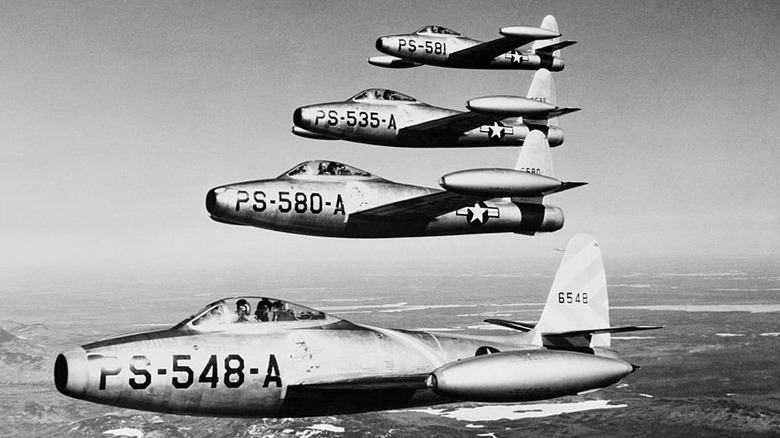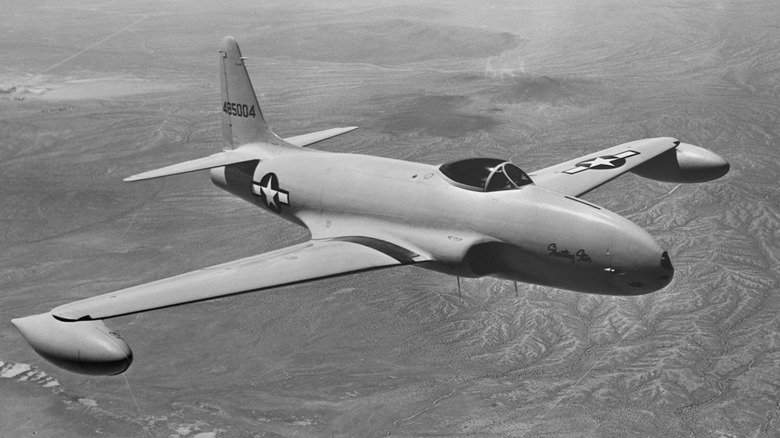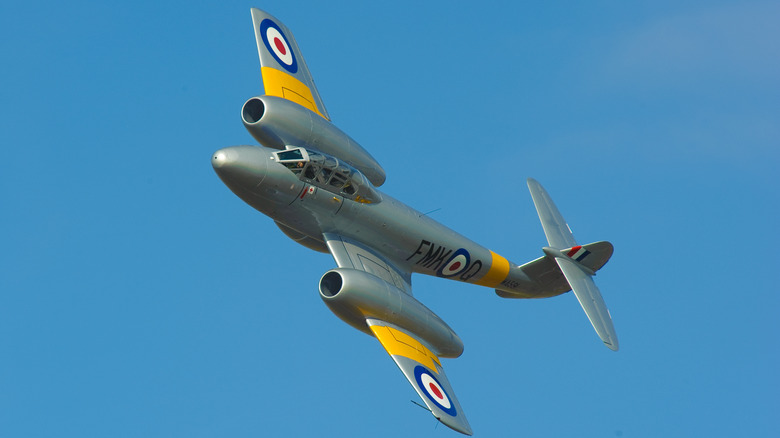These Jets Made A Difference In Operation MiG Alley
The Cold War set the stage for aerial combat between iconic jet-powered fighter aircraft. By the early 1950s, the world's superpowers' first generation of jet fighters were ready for battle. They just needed an opportunity. And in June of 1950, the North Korean leader Kim Il-Sung, provided just that, when he invaded South Korea with the blessing of the Soviet Union.
Urged on by the United States, the United Nations responded, first providing air cover and munitions before adding ground troops to push back the invasion. American pilots, displaying unparalleled courage, took to the skies in their new fighter jets. Meanwhile, Soviet advisors trained North Korean pilots and took to the skies despite Soviet assurances that their military personnel was taking a purely advisory role. This was the first time the Cold War adversaries faced off in the skies over an Asian peninsula, but it wouldn't be the last — American jets would make a huge difference in the Vietnam War a few years later.
The result was an intense air war in northwestern Korea, a strategically crucial area that NATO pilots would later nickname "MiG Alley." The primary Soviet fighter, the Mikoyan and Gurevich (MiG) 15, was a formidable foe. However, the United States had its own advanced fighters to throw into the fray. By 1951, the superpowers were set for the first air war of the jet age, squaring off for domination of the skies over Korea.
Come with us as we explore some of the most iconic planes of the 20th century in our examination of the aircraft that made a difference in Operation MiG Alley.
MiG-15
In 1939, Joseph Stalin ordered engineers Artyom Mikoyan and Mikhail Gurevich to establish an experimental design department. Over the years following, World War II accelerated technology and air war tactics. By 1946, the MiG-15 was on draft boards. The developers wanted a combat jet that could fight above 36,000 feet.
The MiG-15 first took to the skies in 1948, and production commenced in 1949. With a swept-wing design, the MiG 15 outclassed the American jet fighters of the time. Armed with a single 37 mm gun and a pair of 23 mm cannons, the MiG-15 sought to disintegrate bombers. With a ceiling of 51,000 feet, the jet had a maximum speed of 611 mph and a range of 1,250 miles. A reverse-engineered Kilimov VK-A engine provided 6,000 pounds of thrust.
The North Koreans and Soviets craftily based their MiGs over the Yalu River in China — a place American command forbade pilots to go for fear of sparking a wider war. Their primary objective was to prevent B-29 bombing missions, and from that position, they would sweep over the border, hit, and run.
In April 1951, the first significant dogfights began occurring in MiG Alley. Soviet and Chinese Mig-15s marked with North Korean insignia would strike. Needing to stay close to the border, their patrol pattern created an unusually crowded airspace — Mig Alley. The MiGs were ordered not to stray from Communist-controlled areas. MiG pilots found themselves consistently outclassed by American pilots, especially those in the F-86 Sabre, which dominated the skies for the duration of the Korean War.
North American F-86 Sabre
With a design informed by German information captured by the United States at the end of the Second World War, the swept-wing F-86 Sabre made its first flight in October 1947, setting a world speed record of 670.9 mph a mere four months later. Each aircraft received a set of six Browning M-3 .50 cal machine guns packed into the nose. A General Electric J47 providing 5,200 pounds of thrust propelled it to a maximum speed of 685 mph, with a range of 1,200 miles and a ceiling of 49,000 feet. That extra speed came in handy during the Korean War, as Sabres had to travel 200 miles just to reach MiG alley from their bases in Kimpo and Suwon, which left them with only 20 minutes of flight time when there.
The Sabre proved to be the premier fighter of the war. Their deployment ramped up when it became clear that the American pilots were not facing a depleted air force of poorly trained Chinese and Korean pilots — American pilots reported hearing Russian on the radios during combat, even though the Soviets denied it for decades.
Despite the Soviet pilots' skill, the F-86 shot down 792 MiGs, achieving an absurd 8:1 kill ratio. Though flying against a more than competent MiG-15, the American pilots were far better trained than the enemy pilots, as shown by their success in the skies over Korea. The United States and Canada produced over 5,500 Sabres in total.
Republic F-84 Thunderjet
Republic, known for the famous and beloved World War II-era P-47 Thunderbolt, continued to operate as a manufacturer after World War II ended. The second jet fighter of the Army Air Forces to be granted wide-scale production, the F84 first flew in 1946. Meant to serve as an escort fighter and fighter-bomber, with duties including carrying nuclear weapons, the Thunderjet wasn't perfect.
Powered by an Allison J35 engine with 4,900 pounds of thrust, the Thunderjet could carry six .50-cal machine guns, eight 5-inch rockets, or up to 2,000 pounds of bombs. With a max speed of 620 mph and a ceiling of 43,000 feet, the Thunderjet could travel 1,485 miles without refueling. Its straight-wing design came straight off previous-generation pursuit aircraft, which prevented it from reaching the speeds of the later F-86 Sabre. About 4,400 Thunderjets came off assembly lines before production ceased in 1953.
On April 12, 1951, 50 F-84 Thunderjets escorting a flight of B-29 Superfortresses on a bombing run targeting communist supply lines became the first American aircraft to encounter the Soviets' new fighter. 30 MiG-15s swooped into the formation, ultimately downing a trio of Superfortresses. The less agile F-84 was virtually helpless against the Russian jets. Aviation historians called it Black Thursday, and it marked the beginning of a new air war between Sabres and MiGs. The Thunderjets still enjoyed a stellar career as ground attack aircraft throughout the war after the Sabre took over dogfighting duties.
Lockheed P-80 Shooting Star
Designed in 1943, Lockheed made the then-named XP-80's maiden flight on January 8, 1944. Though four experimental aircraft made their way to Europe for testing, the war ended before they could take to the skies. Designed for dual duty, the fighter-bomber came with an armament of six .50-cal machine guns and eight 5-inch rockets or 2,000 pounds of bombs. An Allison J33 provided 5,400 pounds of thrust, pushing the airframe to a max speed of 480 mph with a range of 1,090 miles, and a 46,800-foot operational ceiling.
On November 8, 1950, the beginning of a new era dawned in the skies over the Korean-Chinese border. Straight-winged and relatively slow, four Shooting Stars from the Fifty-First Fighter Wing were already long in the tooth by jet standards. After strafing communist ground forces, the P-80s suddenly found themselves up against a whole new enemy when a flight of 10 MiG-15s jumped their formation. This was the first jet-on-jet aerial dogfight in history.
There is a dispute about who recorded the first actual jet-on-jet aerial kill, with the Soviets claiming one the Americans attributed to ground fire and the Americans claiming one the Soviets deny. But we know the P-80 Shooting Star did not fare well in Korea, with seventeen lost in air-to-air combat against six claimed MiG-15s. If nothing else, the Shooting Star paved the way for the jet aircraft that came after. Lockheed Martin, the plane's designer, still develops state-of-the-art weapon systems from hypersonic missiles to high-tech fighter jets for the United States.
Gloster Meteor
The British-produced Gloster Meteor was the only Allied jet fighter of the Second World War. Though it never faced off against the world's first jet fighter, the German Me-262, the Meteor did see duty shooting down V2 rockets. By the time of the Korean War, the Gloster Meteor was severely outclassed. Despite a record-breaking pedigree, advances in jet technology came so quickly that just seven years after its inaugural flight, it was essentially a relic.
Twin Rolls Royce Derwent 8 turbojets powered the Meteor to a 584-mph maximum speed. With a 43,000-foot ceiling and a maximum range of about 600 miles, the Metor was no match for the MiG-15. Nonetheless, the Royal Australian Air Force deployed the No 77 Squadron, equipped with Meteor Mk.8 fighters to Korea in April 1951. The first three engagements against MiGs saw a single MiG-15 merely damaged for the loss of one Meteor shot down and three others damaged. The writing was on the wall: The Meteor may have made waves in the last war, but this was a new age.
However, the limited role of the Meteor was less disastrous than one might imagine. By the time the authorities pulled the No 77 Squadron from combat in December of 1951, the Metors had lost four aircraft, but claimed five MiGs destroyed. Still, compared to the incredible numbers of the F-86 Sabre, the Meteor was basically washed up as a jet fighter from the outset of the war.
